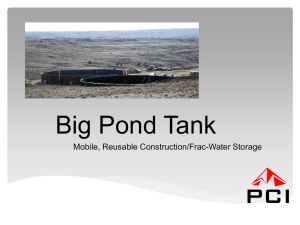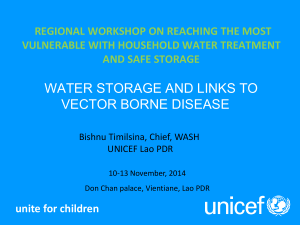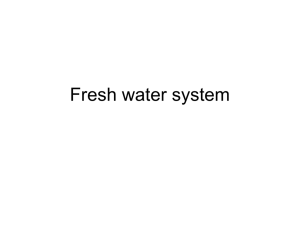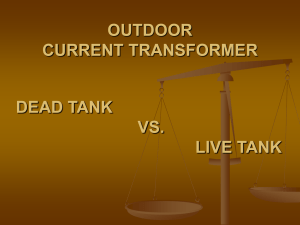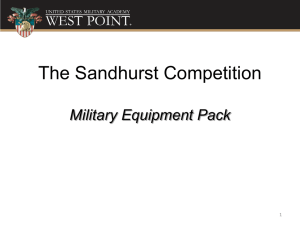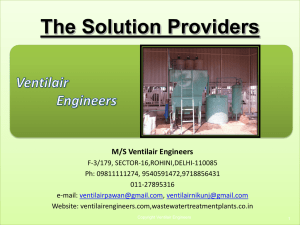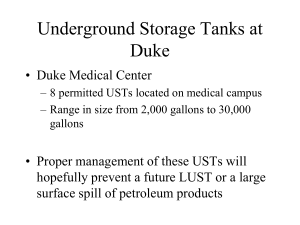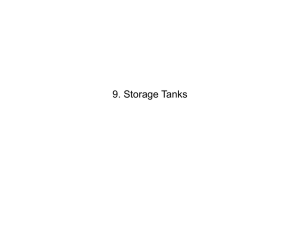Considerations for the Engineering and Design of
advertisement
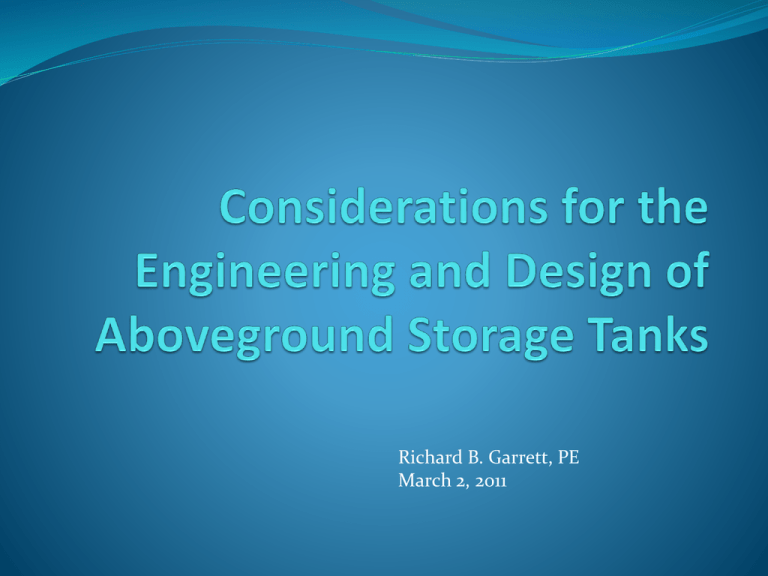
Richard B. Garrett, PE March 2, 2011 Issues covered in this Presentation: Considerations for determining size of tank desired. Owner’s perspective of what information should be conveyed to tank design team. Comparison of Geodesic Dome vs. Cone Roof tanks. Issues to consider per NFPA 30. Miscellaneous Safety considerations. Maintenance considerations. Options for foundation design. Check Requirements – State Web Page 1. Establish product, whether or not Internal Floating Roof will be used and type / dimensions of IFR 2. Determine Desired Working Volume: Daily Throughput x (Resupply Interval + Safety Factor) 10,000 bbl/day, 7 day resupply, 3 day safety stock Minimum Working Volume = 100,000 bbl Highest impact to available capacity is Internal Floating Roof Overfill or Damage level (Approx. 3’ from top of tank) High – High Alarm High Level Alarm Normal Fill Distance between levels is based on maximum fill rate x response time (usually 5 minutes or 6” minimum) Bottom of tank minimum level depends on floating suction geometry to keep liquid from falling below roof for emissions. Normally set around 3’ - 4’. Expect to lose about 7’ – 8’ total height from volume with IFR. Usable tank volume estimation Tank Height Internal Floating Roof Secondary Seal Damage / overfill from top of tank High - High High Level Normal Fill Floating Roof at low legs (Min) Working height 56 ft Volumes for various tank diameters 24 " 15 " 42 6 6 6 " (using 3" safety factor) " " " 42 " 52.5 52.0 51.5 51.0 ft ft ft ft 3.5 ft 47.5 ft Tank Diameter 70 80 90 100 110 120 125 Shell Volume at Working Volume Normal Fill Tank Heel Volume (BBL) (BBL) (BBL) (BBL) 35,983 34,955 2,399 32,556 46,998 45,655 3,133 42,522 59,482 57,782 3,965 53,817 73,434 71,336 4,896 66,441 88,856 86,317 5,924 80,393 105,746 102,724 7,050 95,675 114,741 111,463 7,649 103,814 Tank Design Data Code: API 650 Inside Diameter: 125'-0" Height: 56'-0" Nominal Capacity: 114,741 BBL Maximum Capacity: 111,463 BBL Net Work Capacity: 103,814 Product: Gasoline Product Specific Gravity: 0.74 Design Specific Gravity: 1.0 Design Liquid Level: 51'-0" Internal Pressure: Atmospheric External Pressure: Atmospheric Maximum Design Temperature: 200° F Maximum Operating Temperature: 200° F Design Metal Temperature: 58° F Wind Code: API 650, 11th Ed. Wind Speed: 150 MPH Wind Check: As-Built Wind Importance Factor: 1.0 Earthquake Code: API 650, 11th Ed. Earthquake Zone: Site Coefficient: Site Class D Earthquake Importance Factor: 1.0 Tank Fill Rate: 6,500 BBL/Hr Tank Suction Rate: 5640 gpm Shell Insulation Thickness: None Bottom Design Data Material Specification: A36 Welding: Lap Welded Corrosion Allowance: 1/16" Slope: 1" in 10'-0" Shovel Bottom Annular Plate Data Material Specification: A36 Welding: Double Butt Welded Corrosion Allowance: 1/16" Fixed Roof Data Type: Two-Bay Rater Supported Cone Material Specification: A36 Welding: Lap Welded Uniform Live Load: 20 PSF Additional Dead Load: None Plate corrosion Allowance: None Struc Corrosion Allowance: None Slope: 3/4" in 12" Roof Insulation Thickness: None Floating Roof Data Type: Internal Reverse Slope Outer Rim Corrosion Allowance: None Deck Corrosion Allowance: None External Roof Cone Roof vs. Geodesic Dome Roof Design Considerations – perimeter railing vs. perimeter wind girder designed for access to inspection ports. Maintenance of coating, vs. panel seams Overall Cost Comparison Overall Height – no real limitations, guided mainly by: Local codes, zoning restrictions on height limitations Consider available water pressure height to fight fires Aesthetics compared with other tanks Managing tank alignment if more than one live at same time Consider Operators – if over 60’, may need intermediate landing Geodesic Dome vs. Cone Roof 48’ Geodome with perimeter walk/girder 56’ High Cone with perimeter railing Net Positive Suction Head Required NPSHR – compare greater of NPSHR, tank outlet, floating suction, bottom of tank roof to determine minimum tank level. Remember to take into account all losses from the point of suction to the pump inlet. This is especially critical if using a floating suction for product quality. Depending on the geometry of the swivel, you could experience more loss through that one item than the whole length of piping. Random Design / Safety Issues Emissions options – even though IFR may not be required for Distillate (Jet, Diesel, Kerosene), including this control measure will reduce calculated emissions and may keep you from needing a Title 5 permit. Tank stairs are laid out for convenience, usually along the normal operator walk path. However, from a safety standpoint, tank stairs or walkways providing tank top access should not cross tank valves. As indicated in previous presentations, incorporating a corrosion allowance for bottom and shell, especially if prior experience shows potential areas of corrosion in similar service tanks, can pay big dividends down the road. Tank Anchoring may be required for not only earthquake areas, but also due to high wind (hurricanes), especially with diameter to height ratio less than 1.5. For product quality and to facilitate removal of water, consider using single sloped bottom with deep sump. Fire Protection - NFPA Fire Protection – As mentioned in previous presentations, NFPA sets minimum requirements that local AHJ can increase at their discretion. For example, Section 22.8.2 states that “…floating roof tanks containing any liquid shall not require protection when installed in accordance with this chapter.” However some local departments still require foam protection for these type of tanks. Note – Requirements of Chapter 22 either require remote impoundment, intermediate diking, or other engineered option. Spacing is essentially 1/6 sum of diameters of adjoining tanks, up to 150’ diameter. Larger diameter may require increase to 1/4 sum of diameters. If required, you might want to consider the use of underground HDPE for transmission lines. Alternative usually requires application of sprinkler code, which requires supports at 15’ on center, designed to support 5 x the weight of the lines plus 150 lbs. Coatings Many municipalities now require blast media to be collected and properly disposed of. On site, this can be difficult and costly. One option would be to have shell plate primed before shipping and installation. Bottom is likely to contact with water, consider good thin film coating to extend life. Depending on product service, may want to coat inside of tank – ie: Ethanol – potential corrosive stress cracking Avgas – tends to be more corrosive than other finished products. The best intentions mean nothing – a key quality control measure is Coating Inspections – especially in smaller facilities. Bring in early to have input into specification, such as surface preparation, maximum humidity allowed, admixtures for holding blast, recoat window, etc. Foundation Alternatives Excavate & replace unsuitable soils Piles – Driven to refusal, can disturb nearby structure Auger cast – less disturbance Both still require pile caps to transmit load from bottom to pilings. Soil Stabilization – Low disturbance to nearby structures Reduces waste removal With proper testing and documentation, binder material can serve as remediation Check for Requirements Questions? Richard B. Garrett rick0702@msn.com

